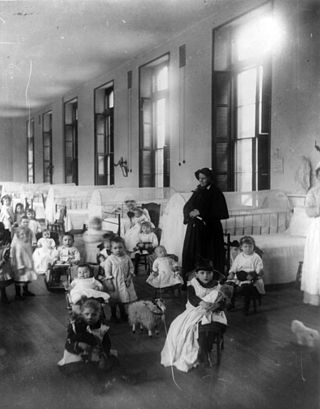Related Research Articles

Adoption is a process whereby a person assumes the parenting of another, usually a child, from that person's biological or legal parent or parents. Legal adoptions permanently transfer all rights and responsibilities, along with filiation, from the biological parents to the adoptive parents.
Divorce is the process of terminating a marriage or marital union. Divorce usually entails the canceling or reorganizing of the legal duties and responsibilities of marriage, thus dissolving the bonds of matrimony between a married couple under the rule of law of the particular country or state. It can be said to be a legal dissolution of a marriage by a court or other competent body. It is the legal process of ending a marriage.

Parenting or child rearing promotes and supports the physical, emotional, social, spiritual and cognitive development of a child from infancy to adulthood. Parenting refers to the intricacies of raising a child and not exclusively for a biological relationship.
A single parent is a person who has a child or children but does not have a spouse or live-in partner to assist in the upbringing or support of the child. Reasons for becoming a single parent include decease, divorce, break-up, abandonment, becoming widowed, domestic violence, rape, childbirth by a single person or single-person adoption. A single parent family is a family with children that is headed by a single parent.

A sibling is a relative that shares at least one parent with the subject. A male sibling is a brother and a female sibling is a sister. A person with no siblings is an only child.
Parental alienation is a theorized process through which a child becomes estranged from one parent as the result of the psychological manipulation of another parent. The child's estrangement may manifest itself as fear, disrespect or hostility toward the distant parent, and may extend to additional relatives or parties. The child's estrangement is disproportionate to any acts or conduct attributable to the alienated parent. Parental alienation can occur in any family unit, but is claimed to occur most often within the context of family separation, particularly when legal proceedings are involved, although the participation of professionals such as lawyers, judges and psychologists may also contribute to conflict.

A dysfunctional family is a family in which conflict, misbehavior, and often child neglect or abuse or all of the above on the part of individual parents occur continuously and regularly. Children that grow up in such families may think such a situation is normal. Dysfunctional families are primarily a result of two adults, one typically overtly abusive and the other codependent, and may also be affected by substance abuse or other forms of addiction, or sometimes by an untreated mental illness. Parents having grown up in a dysfunctional family may over-correct or emulate their own parents. In some cases, the dominant parent will abuse or neglect their children and the other parent will not object, misleading a child to assume blame.
An only child is a person with no siblings either by birth or adoption.
In evolutionary psychology, the Cinderella effect is the phenomenon of higher incidence of different forms of child abuse and mistreatment by stepparents than by biological parents. It takes its name from the fairy tale character Cinderella, which is about a girl who is mistreated by her stepsisters and stepmother. Evolutionary psychologists describe the effect as a byproduct of a bias towards kin, and a conflict between reproductive partners of investing in young that are unrelated to one partner.

LGBT parenting refers to lesbian, gay, bisexual, and transgender (LGBT) people raising one or more children as parents or foster care parents. This includes: children raised by same-sex couples, children raised by single LGBT parents, and children raised by an opposite-sex couple where at least one partner is LGBT.

A parenting style is a pattern of behaviors, attitudes, and approaches that a parent uses when interacting with and raising their child. The study of parenting styles is based on the idea that parents differ in their patterns of parenting and that these patterns can have a significant impact on their children's development and well-being. Parenting styles are distinct from specific parenting practices, since they represent broader patterns of practices and attitudes that create an emotional climate for the child. Parenting styles also encompass the ways in which parents respond to and make demands on their children.
Meta-emotion is "an organized and structured set of emotions and cognitions about the emotions, both one's own emotions and the emotions of others". This broad definition of meta-emotion sparked psychologists' interest in the topic, particularly regarding parental meta-emotion philosophy.
Gene–environment correlation is said to occur when exposure to environmental conditions depends on an individual's genotype.
Parent management training (PMT), also known as behavioral parent training (BPT) or simply parent training, is a family of treatment programs that aims to change parenting behaviors, teaching parents positive reinforcement methods for improving pre-school and school-age children's behavior problems.

Alcoholism in family systems refers to the conditions in families that enable alcoholism and the effects of alcoholic behavior by one or more family members on the rest of the family. Mental health professionals are increasingly considering alcoholism and addiction as diseases that flourish in and are enabled by family systems.
The effects of domestic violence on children have a tremendous impact on the well-being and developmental growth of children witnessing it. Children who witness domestic violence in the home often believe that they are to blame, live in a constant state of fear, and are 15 times more likely to be victims of child abuse. Close observation during an interaction can alert providers to the need for further investigation and intervention, such as dysfunctions in the physical, behavioral, emotional, and social areas of life, and can aid in early intervention and assistance for child victims.
Triple P is a parenting intervention with the main goals of increasing the knowledge, skills, and confidence of parents and reducing the prevalence of mental health, emotional, and behavioral problems in children and adolescents. The program was originally specifically tailored for at risk children and parents, but there are now different levels of Triple P designed to work together as a broad, universal, public health approach. This program is based on principles of community psychology.
Childhood obesity is defined as a body mass index (BMI) at or above the 96th percentile for children of the same age and sex. It can cause a variety of health problems, including high blood pressure, high cholesterol, heart disease, diabetes, breathing problems, sleeping problems, and joint problems later in life. Children who are obese are at a greater risk for social and psychological problems as well, such as peer victimization, increased levels of aggression, and low self-esteem. Many environmental and social factors have been shown to correlate with childhood obesity, and researchers are attempting to use this knowledge to help prevent and treat the condition. When implemented early, certain forms of behavioral and psychological treatment can help children regain and/or maintain a healthy weight.
Father absence occurs when parents separate and the father no longer lives with his children and provides no parental investment. Parental separation has been proven to affect a child's development and behavior. Early parental divorce has been associated with greater internalizing and externalizing behaviors in the child, while divorce later in childhood or adolescence may dampen academic performance.

Nicholas H. Wolfinger is an American researcher, academic and educator. He is Professor in the Department of Family and Consumer Studies and Adjunct Professor of Sociology at the University of Utah. His research is focused on sociology of the family, religion, social demography and quantitative and qualitative methods.
References
- ↑ Lucas, R (2007). "Adaptation and the set-point model of subjective well-being: Does happiness change after major life events?". Current Directions in Psychological Science. 16: 75–79. doi:10.1111/j.1467-8721.2007.00479.x. S2CID 18842089.
- ↑ School of Family, Consumer, and Nutrition Sciences (Miller, 2003)
- ↑ 1. Wallerstein, J. S., Lewis, J. M., & Blakeslee, S. (2001). The Unexpected Legacy of Divorce: The 25 Year Landmark Study. Hachette Books. ISBN 0-7868-6394-3
- ↑ Waite, L. J., Browning, D., Doherty, W. J., Gallagher, M., Luo, Y. & Stanley, S. M. (2003). "Does Divorce Make People Happy? Findings from a Study of Unhappy Marriages". Institute for American Values. ISBN 1-931764-03-4
- ↑ Tebeka, S.; Hoertel, N.; Dubertret, C.; Le Strat, Y. (2016). "Parental divorce or death during childhood and adolescence and its association with mental health". The Journal of Nervous and Mental Disease. 204 (9): 678–685. doi:10.1097/NMD.0000000000000549. PMID 27356119. S2CID 38403800.
- ↑ Shanahan, M. J. (2000). "Pathways to Adulthood in Changing Societies: Variability and Mechanisms in Life Course Perspective". Annual Review of Sociology. 26: 679. doi:10.1146/annurev.soc.26.1.667.
- ↑ Jacquet, S. E.; Surra, C. A. (2001). "Parental divorce and premarital couples: commitment and other relationship characteristics". Journal of Marriage and Family. 63 (3): 627–638. doi:10.1111/j.1741-3737.2001.00627.x.
- ↑ Amato, P. R.; Booth, A. (1999). "The consequences of divorce for attitudes toward divorce and gender roles". Journal of Family Issues. 12 (3): 306–322. doi:10.1177/019251391012003004. S2CID 145631216.
- ↑ Jennings, A. M.; Salts, C. J.; Smith, T. A. Jr (1992). "Attitudes toward marriage: Effects of parental conflict, family structure, and gender". Journal of Divorce and Remarriage. 17: 67–78. doi:10.1300/j087v17n01_05.
- 1 2 3 4 5 Steinbach, Anja (2 July 2018). "Children's and Parent's Well-Being in Joint Physical Custody: A literature Review". Wiley Online Library. Retrieved 9 April 2023.
- ↑ 1. Fagan, P. F. & Rector, R. E. (2000). The Effects of Divorce in America. The Heritage Foundation. Backgrounder #1373.
- 1 2 3 1. Ahrons, C. (2004). We're Still Family: What Grown Children Have to Say About Their Parents' Divorce. Harper Collins. ISBN 0-06-019305-0.
- ↑ 1. Hetherington, E. M. & Kelly, J. (2002). For Better or For Worse: Divorce Reconsidered. W. W. Norton & Company. ISBN 0-393-04862-4
- ↑ Burgoyne, Carole B.; Hames, Rebecca (2002). "Views of Marriage and Divorce". Journal of Divorce & Remarriage. 37 (1–2): 75–100. doi:10.1300/J087v37n01_05. S2CID 141461643.
- ↑ Wolfinger, Nicholas H. (2011-05-01). "More Evidence for Trends in the Intergenerational Transmission of Divorce: A Completed Cohort Approach Using Data From the General Social Survey". Demography. 48 (2): 581–592. doi: 10.1007/s13524-011-0025-4 . ISSN 0070-3370. PMID 21509648.
- ↑ "Short and long term effects of parental divorce | Institute for Population Research".
- 1 2 Braver, S. L.; Ellman, I. M.; Fabricius, W. V. (2003). "Relocation of children after divorce and children's best interests: New evidence and legal considerations". Journal of Family Psychology. 17 (2): 206–219. doi:10.1037/0893-3200.17.2.206. PMID 12828017.
- ↑ Sbarra, David A.; Nietert, Paul J. (January 2009). "Divorce and Death: Forty Years of the Charleston Heart Study". Psychological Science. 20 (1): 107–113. doi:10.1111/j.1467-9280.2008.02252.x. ISSN 0956-7976. PMC 2977944 . PMID 19076315.